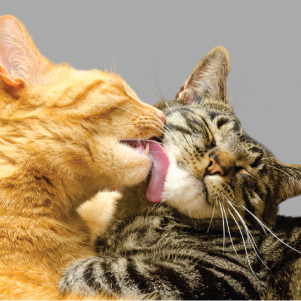
Can You Train a Cat? Some Tips for Cat Training
It is said that cats are not trainable. You may have also heard that cats are the ones who train us! This is just not true – we can all be trained. The key is knowing how cats learn and finding the right motivation.
Let’s see how this works, using an example of a routine activity: grooming your cat. For this, it may help to create a calm environment first by using a stress-reducing product like FELIWAY Optimum.

Step 1:
- Discover what motivates your cat. It might be food, strokes or playtime – find out what it is that they love and try saving this for training sessions.
Step 2:
- Add a signal to the situation. Cats do not like surprises, so plan your training to take place in the same area each time if possible. Use a signal to mark the start of the training. For example, always groom your cat on top of the living room table with them on a towel (which has the added benefit of making the surface softer and less slippery for your cat).
Step 3:
- Choose a word or phrase that marks the start of the activity for example, “I’m going to make you look good” or “Grooming time!”. Use a calm positive voice.
Step 4:
- Move close to your cat, say your chosen phrase, show them that you have their favorite reward and move to where the towel is placed. On the way, keep encouraging your cat to join you – otherwise, they might leave.

Step 5:
- Let your cat walk onto the towel on their own. Do not pick your cat up to move them, unless they are comfortable with this. Instead, a trail of small pieces of a tasty treat can entice them to the towel. When your cat is on the towel, praise and reward them.
You may need to repeat some steps several times. Apart from knowing what you are doing and finding the right motivation, you must be patient and determined. Never give up!
Step 6:
- Pet your cat gently. Remember that cats usually love to be petted under the chin, cheeks and around the ears. Avoid unpleasant areas for your cat, such as their eyes and ears. Pet them for just 5-10 seconds, then stop and reward your cat if they have remained comfortable with this interaction.
Get your cat used to this routine by giving them gentle strokes and then their reward. Keep repeating until they get used to the link between being on the towel and receiving rewards.

Step 7:
- Show your cat the brush but do not touch them with it. Follow this sequence: show the brush, take it away, pet your cat, take your hand off, reward them, and repeat. If your cat has had a bad experience with grooming this process may take longer. In that case try buying a different brush as it may help to speed the process up.
So far, your cat has not been brushed, but all the previous steps are key to success.
Step 8:
- Move the brush closer to your cat’s skin and brush them very gently with one stroke, take the brush away and reward your cat. Start brushing their favorite body parts but do not do it for long – remember to stop before your cat gets tired. If the session has an unpleasant end, they might not be keen on doing it again, so it is better to brush small bits several times.
Step 9:
- Increase the area you brush bit by bit in every session until you can groom all of their coat.
Step 10:
- Remove rewards gradually. Once the activity’s routine is set, keep 2-3 rewards per session. Food treats must be removed little by little, but do not stop praising your cat and petting them gently while brushing.
Now you may be wondering, “But when can I move on from one step to the other?” or “How many weeks does it usually take?”
The answer to both questions depends on you and your cat. It will depend on how many times you do the training each day and how positive the experience is for them. I recommend you do this 2-3 times a day, but always stop before your cat gets tired, bored or frustrated. This way, it is more like a fun playtime for them!
You may think that the shorter the session, the longer it will take to get your cat used to it. However, this is not true as longer training sessions can end up being an unpleasant activity for your cat, and it will take longer to move to the next step. You will soon see that short and regular sessions do the trick.
Another question you may be asking yourself is, “Is this routine only suitable for kittens or young adults?” The answer is no. It is always a good time to make grooming (or other routine activities) into something pleasant.
All the time invested in each activity will pay off when the training period is over and becomes an easy and pleasurable task for you and your cat!

























